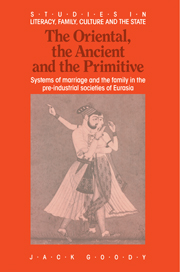 The Oriental, the Ancient and the Primitive
The Oriental, the Ancient and the Primitive Published online by Cambridge University Press: 09 January 2010
In our examination of the woman's property complex (which is the short-hand name I give to the cluster of variables linked to diverging devolution), we have found broadly three ways of devolving property on women, all of which were found in rural Greece, sometimes one receiving more stress in one region at a certain time but all present in the repertoire of the system if not of a local area at any one point in time. At one pole, the most male-oriented end, we find the stress placed on marriage prestations from the groom which were used, at least in part, as an indirect dowry for the wife; such practices vary according to the proportion which is retained by father and daughter respectively. In some codes, such as the Law of Manu, it was strictly forbidden for the father to retain or even transmit anything at all; the indirect dowry was out, not because it entailed ‘bride-purchase’ but because transfers from the groom implied that the father was unable to provide support for his own daughter. In some circumstances a man may keep back some of these payments, though at the same time he makes prestations to his daughter which may well be seen as ‘balancing the books’, or the daughter may allow her property to rest under her kin's control for the sake of protecting it. In most upper groups emphasis is placed on the direct endowment of a daughter at marriage.
To save this book to your Kindle, first ensure [email protected] is added to your Approved Personal Document E-mail List under your Personal Document Settings on the Manage Your Content and Devices page of your Amazon account. Then enter the ‘name’ part of your Kindle email address below. Find out more about saving to your Kindle.
Note you can select to save to either the @free.kindle.com or @kindle.com variations. ‘@free.kindle.com’ emails are free but can only be saved to your device when it is connected to wi-fi. ‘@kindle.com’ emails can be delivered even when you are not connected to wi-fi, but note that service fees apply.
Find out more about the Kindle Personal Document Service.
To save content items to your account, please confirm that you agree to abide by our usage policies. If this is the first time you use this feature, you will be asked to authorise Cambridge Core to connect with your account. Find out more about saving content to Dropbox.
To save content items to your account, please confirm that you agree to abide by our usage policies. If this is the first time you use this feature, you will be asked to authorise Cambridge Core to connect with your account. Find out more about saving content to Google Drive.